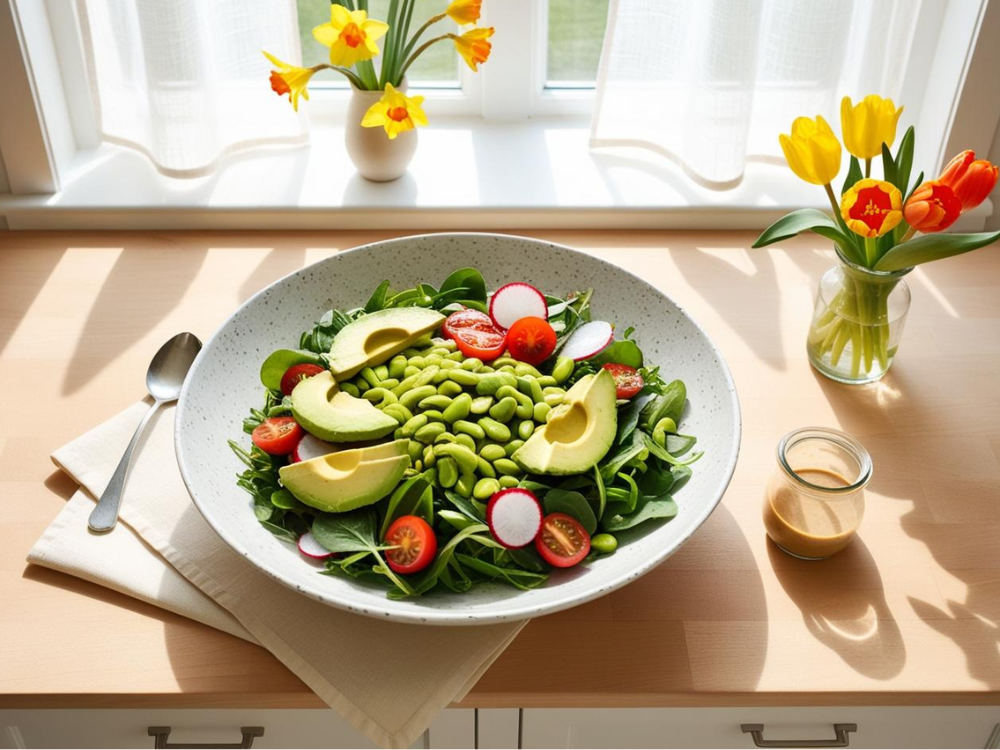Quinoa Buddha Bowl with Lemon Tahini Dressing
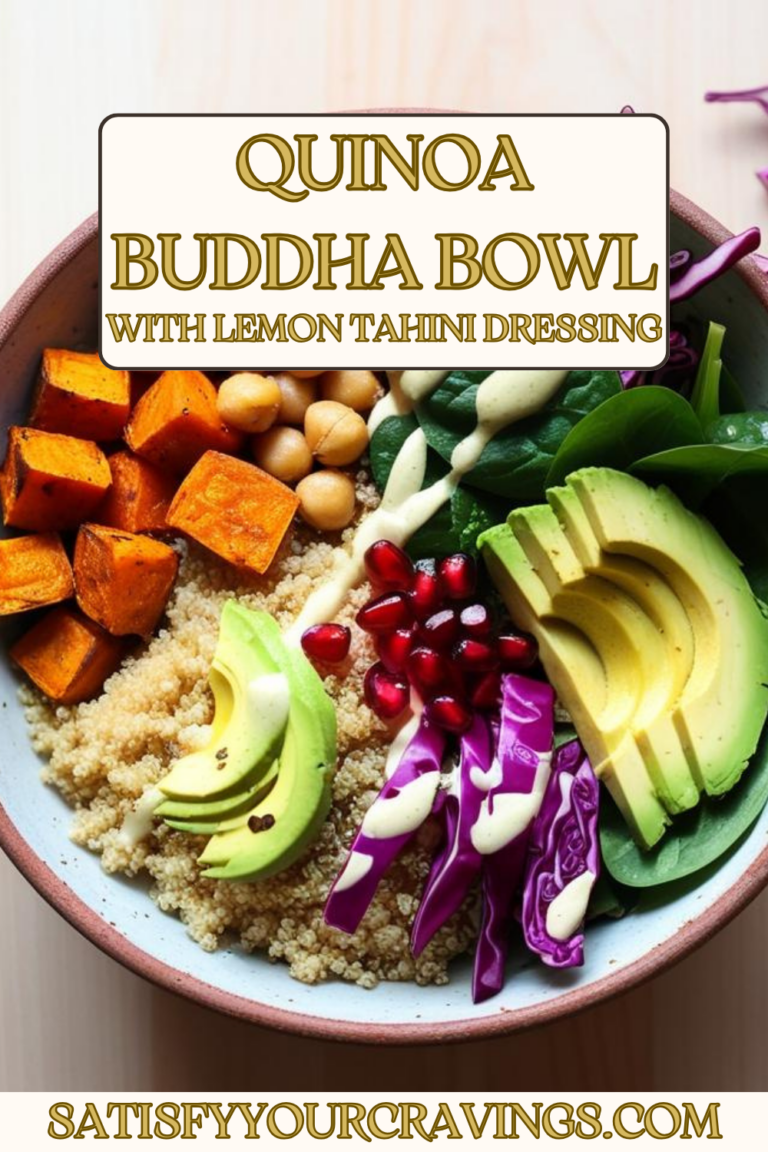
A Wholesome, Flavorful Delight
When it comes to creating a meal that’s both satisfying and nourishing, this Quinoa Buddha Bowl with Lemon Tahini Dressing checks all the boxes. With its vibrant colors, fresh ingredients, and a tangy homemade dressing, it’s the perfect way to enjoy a healthy, balanced meal without sacrificing flavor. Whether you’re a seasoned meal-prepper or just looking for a simple recipe to power you through your day, this bowl is a must-try.
Each bite is a delicious combination of textures and flavors—from the nutty quinoa and roasted sweet potatoes to the crisp spinach and creamy avocado. The zesty lemon tahini dressing ties everything together beautifully, making it a dish you’ll want to enjoy again and again. Plus, it’s entirely plant-based, gluten-free, and easy to customize, making it a versatile option for any lifestyle. Ready to dig in? Let’s get started!
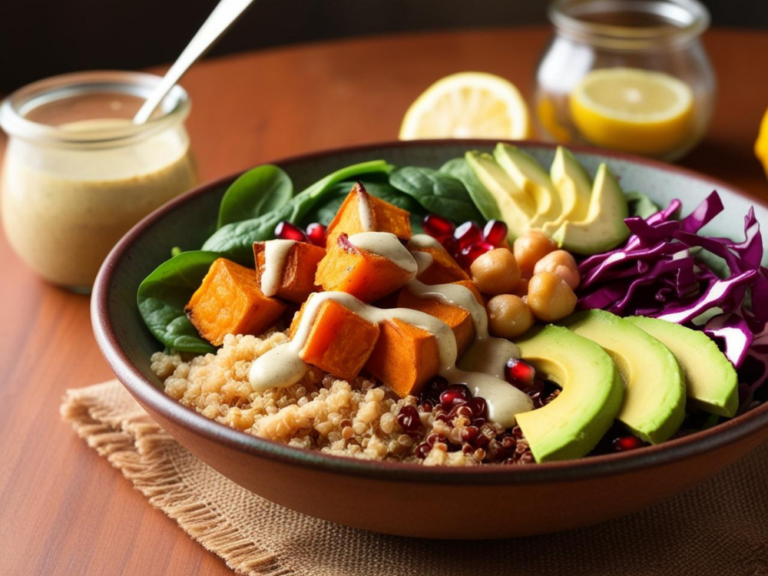
Nutritional Benefits of Ingredients
The Quinoa Buddha Bowl with Lemon Tahini Dressing isn’t just a feast for the eyes—it’s a nutrient-packed powerhouse that fuels your body with everything it needs to feel energized, nourished, and satisfied. Every ingredient in this bowl is chosen not just for its flavor but for its incredible health benefits. Let’s break it down:
Quinoa: The Superfood Base
Quinoa is often referred to as a superfood, and for good reason. It’s one of the few plant-based foods that’s a complete protein, meaning it contains all nine essential amino acids your body needs for muscle repair and overall health. It’s also packed with fiber, which supports digestion and keeps you feeling full longer. On top of that, quinoa is rich in magnesium, which helps regulate muscle and nerve function, and iron, which is vital for carrying oxygen throughout your body. Its slightly nutty flavor and fluffy texture make it the perfect foundation for this bowl.
Sweet Potatoes: Nature’s Energy Boosters
Sweet potatoes are not only delicious but also one of the healthiest root vegetables you can eat. They’re loaded with beta-carotene, a precursor to vitamin A, which is essential for good vision, a strong immune system, and glowing skin. Sweet potatoes are also high in complex carbohydrates, giving you a steady energy boost without the crash. Plus, their natural sweetness pairs beautifully with the earthy quinoa and the zesty lemon tahini dressing.
Chickpeas: Plant-Based Protein Power
Chickpeas are the perfect way to add more protein to this bowl, especially if you’re following a plant-based diet. They’re rich in fiber, which helps with digestion and keeps your blood sugar levels stable. Chickpeas are also an excellent source of iron and magnesium, making them a fantastic addition to support energy production and muscle function. Their slightly nutty flavor and creamy texture make them a versatile and satisfying topping.
Spinach: A Leafy Green Hero
Spinach is a true nutritional hero. It’s packed with vitamins and minerals, including vitamins A, C, and K, which are essential for immune support, skin health, and strong bones. Spinach is also a great source of iron, particularly for those on a plant-based diet, helping to prevent fatigue and support oxygen flow in the blood. Its tender leaves add a fresh, earthy flavor and a pop of green to this bowl.
Avocado: Creamy and Heart-Healthy
Avocado isn’t just creamy and delicious—it’s also a fantastic source of heart-healthy monounsaturated fats. These fats help lower bad cholesterol levels and reduce the risk of heart disease. Avocados are also rich in potassium, which helps regulate blood pressure, and fiber, which aids in digestion. Their smooth, buttery texture perfectly complements the crunch of the other ingredients in this bowl.
Red Cabbage: Vibrant and Packed with Antioxidants
Red cabbage adds a vibrant pop of color and a satisfying crunch to the bowl. It’s packed with antioxidants like anthocyanins, which give it that deep purple hue and help fight inflammation. It’s also high in vitamin C, which supports a healthy immune system, and fiber, which promotes good digestion.
Pomegranate Seeds: Tiny Bursts of Nutrition
Pomegranate seeds are like nature’s little jewels. They add a touch of sweetness and a delightful crunch to the bowl. They’re packed with antioxidants, particularly vitamin C and polyphenols, which help fight free radicals and reduce inflammation. Pomegranate seeds also contain fiber and are known for their heart-healthy benefits.
Tahini: Creamy and Nutrient-Rich
Tahini, made from ground sesame seeds, is a nutritional powerhouse. It’s a great source of healthy fats, plant-based protein, and important minerals like calcium and zinc, which support bone health and a strong immune system. When combined with lemon juice and garlic in the dressing, tahini becomes a creamy, tangy, and utterly irresistible topping that ties all the ingredients together.
Lemon Juice: A Zesty Vitamin Boost
Lemon juice is not just for flavor—it’s also packed with vitamin C, which boosts your immune system, supports collagen production for healthy skin, and enhances the absorption of iron from plant-based foods. Its bright, zesty flavor lifts the entire bowl, making it taste fresh and vibrant.
A Nutritional Symphony in Every Bite
When you combine all these powerhouse ingredients into one bowl, you get a meal that’s not only balanced but also bursting with health benefits. From protein to fiber, healthy fats to essential vitamins and minerals, this bowl provides a perfect harmony of nutrients to fuel your body. Whether you’re looking to boost your energy, support your immune system, or simply enjoy a wholesome meal, this Buddha Bowl has you covered. Plus, it’s plant-based, gluten-free, and easy to customize, making it a versatile choice for any diet or lifestyle.
So go ahead, dig in, and let this nutrient-packed bowl nourish your body and delight your taste buds!
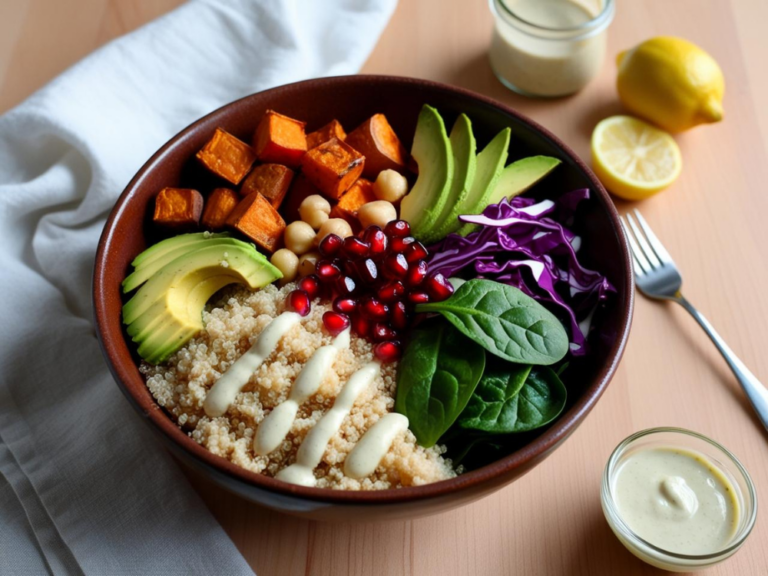
Perfect Pairings for Your Quinoa Buddha Bowl
A Quinoa Buddha Bowl with Lemon Tahini Dressing is a wholesome and satisfying meal on its own, but pairing it with complementary sides, drinks, or even desserts can take your dining experience to the next level. Whether you’re hosting a gathering, enjoying a quiet meal at home, or meal-prepping for the week, these pairing suggestions will enhance the flavors and textures of your Buddha Bowl, making it even more enjoyable.
Refreshing Drinks
Pair your vibrant Buddha Bowl with a drink that enhances its fresh and zesty flavors. Here are a few options:
Lemon-Mint Sparkling Water:
The zesty lemon and refreshing mint in a sparkling water perfectly mirror the citrusy notes of the tahini dressing, cleansing your palate between bites.Green Smoothie:
A nutrient-packed green smoothie with spinach, banana, and a splash of almond milk is a great complement to the Buddha Bowl, boosting the meal’s overall health benefits.Iced Herbal Tea:
A chilled hibiscus or chamomile tea with a slice of lemon adds a subtle sweetness and a calming effect to your meal.Light White Wine or Rosé:
If you’re serving this Buddha Bowl for dinner, a glass of crisp white wine or dry rosé pairs wonderfully with its fresh and earthy flavors.
Sides to Compliment the Bowl
While the Buddha Bowl is hearty on its own, adding a small side can make your meal even more satisfying and diverse.
Simple Side Salad:
Toss together a light salad with mixed greens, cucumber, and a lemon vinaigrette for a refreshing starter or complement.Roasted Vegetables:
Add a side of roasted veggies like broccoli, asparagus, or Brussels sprouts to bring more texture and depth to your plate.Whole Grain Bread or Pita:
Serve a slice of whole grain bread or warm pita on the side to scoop up the extra dressing and veggies.Soup:
A light soup, like a lentil or miso broth, pairs beautifully with the Buddha Bowl, especially during colder months.
Snack or Appetizer Ideas
If you’re hosting a gathering or want to add a small bite to your meal, consider these snackable options:
Hummus with Veggies:
Serve a plate of fresh-cut veggies and creamy hummus to tie in the flavors of the tahini dressing.Stuffed Grape Leaves:
These tangy and savory bites add a Mediterranean twist that pairs well with the flavors in the Buddha Bowl.Roasted Chickpea Snack:
Crunchy roasted chickpeas seasoned with paprika or cumin make a great appetizer and echo the flavors of the bowl.
Desserts to Complete the Meal
After enjoying a light and healthy Buddha Bowl, a small dessert can provide the perfect ending to your meal. Here are a few healthy dessert ideas:
Dark Chocolate-Dipped Strawberries:
The richness of dark chocolate pairs perfectly with the light and fresh flavors of the Buddha Bowl.Citrus Sorbet:
A tangy lemon or orange sorbet is a refreshing way to cleanse your palate after the meal.Chia Seed Pudding:
A creamy chia seed pudding made with almond milk and a touch of maple syrup feels indulgent but keeps the meal balanced and nutritious.
Wine and Beverage Pairing for Special Occasions
For a more sophisticated pairing, choose beverages that enhance the fresh and earthy flavors of the bowl:
- White Wine: A Sauvignon Blanc or Pinot Grigio pairs well with the lemony notes in the dressing.
- Craft Beer: A light, citrusy beer like a wheat ale or saison complements the bowl’s flavors without overpowering them.
Why Pairings Matter
Pairing your Buddha Bowl with the right sides, drinks, or desserts isn’t just about adding more to your meal—it’s about creating a well-rounded dining experience that’s satisfying and memorable. These pairings are designed to complement the bowl’s fresh, zesty, and earthy flavors while keeping the focus on healthy, nourishing choices.
Try one or mix and match to find your perfect combination, and don’t forget to share your pairing ideas with us on social media using #SatisfyYourCravings!
Try some of our other recipes!
How to Make the Quinoa Buddha Bowl Kid-Friendly
The Quinoa Buddha Bowl with Lemon Tahini Dressing is a nutritious meal packed with wholesome ingredients, but getting kids excited about eating it can feel like a challenge. Thankfully, with a few creative tweaks, you can turn this healthy dish into a kid-approved favorite! By focusing on familiar flavors, fun presentations, and interactive elements, you can make this Buddha Bowl a hit with even the pickiest eaters.
1. Use Familiar Ingredients
Kids are more likely to try something new if it includes ingredients they already love. Here are some easy swaps to make the bowl more appealing:
- Sweet Potatoes: Stick with roasted sweet potatoes but cut them into fun shapes like cubes or wedges. Their natural sweetness often appeals to kids.
- Quinoa: While quinoa is a superfood, its texture might be unfamiliar to kids. Mix it with a small amount of rice or couscous to ease them into it.
- Chickpeas: If plain chickpeas aren’t a hit, roast them with a little cinnamon or a sprinkle of cheese to create a crunchy snack-like texture.
- Veggies: Swap out stronger-tasting greens like spinach or kale for milder options like romaine lettuce or shredded carrots. Add veggies kids already enjoy, such as cherry tomatoes or cucumber slices.
2. Simplify the Flavors
Kids often prefer simple and mild flavors. While the lemon tahini dressing is tangy and delicious, you can tone it down to suit younger palates:
- Omit the garlic or reduce the lemon juice to make the dressing less intense.
- Add a small dollop of yogurt to the dressing for a creamier, milder taste.
- Offer the dressing on the side so kids can dip their veggies instead of having everything pre-dressed.
3. Make It Interactive
Kids love meals where they can get involved in the process. Turning this Buddha Bowl into a DIY activity can make it more fun and engaging:
- Set Up a Bowl Bar: Arrange the ingredients in separate bowls and let kids build their own Buddha Bowl. They’ll enjoy the freedom of choosing what goes into their meal.
- Let Them Help: Get kids involved in the kitchen by having them rinse the quinoa, sprinkle the spices on the sweet potatoes, or stir the dressing. A little ownership goes a long way in encouraging them to eat what they’ve helped create.
4. Focus on Presentation
Sometimes, it’s all about how the food looks! A colorful and fun presentation can make kids more excited to dig in:
- Use a Fun Plate or Bowl: Serve the Buddha Bowl in a bright, colorful dish or even a divided plate so kids can see each ingredient separately.
- Make It Cute: Arrange the veggies and quinoa into a smiley face or other fun designs. For example, use avocado slices as a smile and pomegranate seeds as eyes.
- Add a Small Treat: Include a sprinkle of shredded cheese or a few croutons on top as a special touch.
5. Add Kid-Friendly Protein
While chickpeas and quinoa are great sources of protein, some kids might prefer more familiar options. Consider adding:
- Grilled or baked chicken pieces.
- Scrambled or hard-boiled eggs.
- A sprinkle of shredded cheese or a small scoop of hummus for extra flavor.
6. Offer a Fun Drink or Side
Pair the Buddha Bowl with a kid-friendly drink or side dish to make the meal feel complete:
- Smoothie: A fruit smoothie with bananas, strawberries, or a touch of chocolate can make the meal feel like a treat.
- Fruit Skewers: Serve fresh fruit like apple slices or grapes on skewers for a colorful and fun addition.
- Mini Breadsticks or Pita Chips: These make great “dippers” for the dressing or a scoop of hummus on the side.
7. Introduce New Ingredients Gradually
If your child is hesitant about trying new foods, introduce the Buddha Bowl components gradually:
- Start with just quinoa, sweet potatoes, and one veggie they like.
- Slowly add new ingredients over time, such as the dressing, chickpeas, or red cabbage.
8. Make It a Positive Experience
Meal times should be stress-free and fun. Avoid pressuring kids to eat every part of the bowl. Instead:
- Encourage them to try “just one bite” of a new ingredient.
- Praise them for trying something different, even if they don’t finish it.
- Model enjoying the meal yourself—your enthusiasm can be contagious!
Why Make It Kid-Friendly?
Teaching kids to enjoy a variety of healthy foods early on helps set the foundation for a lifetime of good eating habits. The Quinoa Buddha Bowl is an excellent way to introduce them to nutritious, whole foods in a way that feels approachable and fun. With just a few adjustments, you can make this recipe not only kid-friendly but also a regular family favorite!
Encourage your kids to get creative with their bowls and share their unique creations with us on social media using #SatisfyYourCravings. Who knows? They might surprise you with their adventurous eating skills!
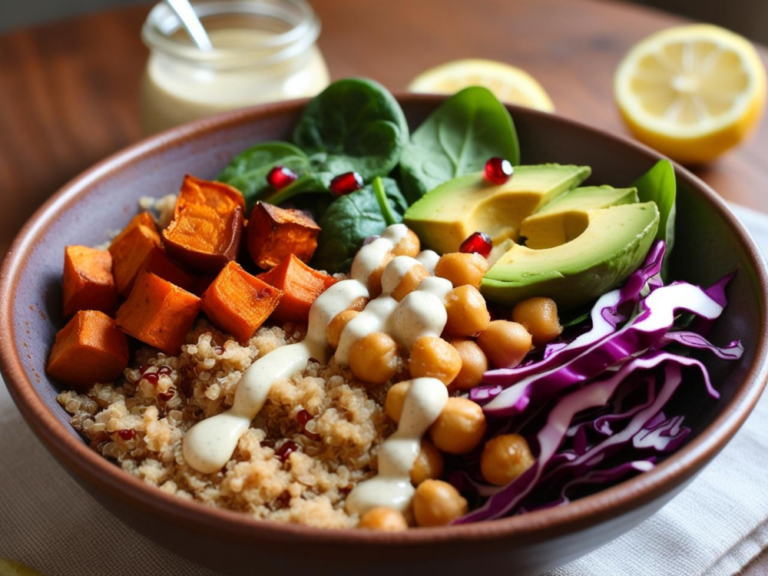
Frequently Asked Questions About the Quinoa Buddha Bowl
Making a delicious and nutritious meal like the Quinoa Buddha Bowl with Lemon Tahini Dressing can spark a few questions, especially if you’re new to Buddha Bowls or plant-based recipes. To help you feel confident in the kitchen and get the most out of this recipe, we’ve compiled answers to some of the most common FAQs. Let’s dive in!
1. What is a Buddha Bowl?
A Buddha Bowl is a colorful, nutrient-packed meal served in a single bowl. It typically includes a base like grains or greens, an assortment of veggies, a protein source (like beans, tofu, or chickpeas), and a flavorful dressing or sauce. The name is inspired by the idea of a bowl overflowing with abundance, much like the rounded belly of Buddha statues.
2. Can I Customize the Ingredients?
Absolutely! One of the best things about Buddha Bowls is how flexible they are. Here are some ideas:
- Grain Swap: Use brown rice, couscous, or farro instead of quinoa. For a low-carb option, try cauliflower rice or zucchini noodles.
- Veggie Variations: Swap sweet potatoes for roasted carrots, Brussels sprouts, or squash depending on the season.
- Protein Options: Add grilled chicken, baked tofu, or a soft-boiled egg for extra protein.
- Dressing Ideas: Experiment with different dressings like a balsamic vinaigrette, spicy peanut sauce, or even a creamy avocado dressing.
3. Is This Recipe Gluten-Free?
Yes, this recipe is naturally gluten-free as long as you use certified gluten-free quinoa and tahini. Always check ingredient labels, especially for condiments, to ensure they’re gluten-free.
4. How Long Does It Take to Make?
The prep and cooking time for this Buddha Bowl is about 35–40 minutes. If you’re meal-prepping or roasting vegetables ahead of time, you can cut that down significantly when it’s time to assemble the bowls.
5. Can I Meal Prep This Recipe?
Definitely! This Buddha Bowl is perfect for meal prep. Prepare the individual components—quinoa, roasted sweet potatoes, chickpeas, and dressing—in advance. Store them in separate containers in the fridge, and assemble your bowl fresh when you’re ready to eat. This method keeps everything fresh and ensures nothing gets soggy.
6. How Do I Store Leftovers?
- Quinoa and Roasted Veggies: Store in an airtight container in the refrigerator for up to 5 days. Reheat before serving if desired.
- Dressing: Keep the dressing in a sealed jar or container in the fridge for up to 5 days. Shake well before using as it may separate.
- Fresh Veggies: Store these separately in a container lined with a paper towel to keep them crisp. Delicate veggies like avocado should be sliced fresh before serving.
7. What If I Don’t Have Tahini?
No tahini? No problem! You can substitute it with almond butter, sunflower seed butter, or even Greek yogurt for a creamy alternative. Just adjust the other ingredients in the dressing to balance the flavor.
8. How Can I Make It Spicier?
If you love a little heat, here are a few ways to spice things up:
- Add a pinch of cayenne pepper to the dressing.
- Sprinkle red chili flakes or a dash of hot sauce over the finished bowl.
- Roast the sweet potatoes with smoked paprika or chili powder for a subtle kick.
9. Can I Serve This Cold or Warm?
You can serve this Buddha Bowl either way! It’s delicious as a warm, comforting meal right after cooking or as a chilled, refreshing dish when you’re on the go. For meal-prepped bowls, you can mix and match—warm the quinoa and sweet potatoes while keeping the veggies fresh and crisp.
10. What Makes This Bowl So Healthy?
This bowl is a nutritional powerhouse because it’s packed with:
- Complete protein from quinoa and chickpeas.
- Fiber from vegetables and grains to support digestion.
- Healthy fats from avocado and tahini, which promote heart health.
- Vitamins and minerals from fresh veggies, supporting overall wellness.
11. Can Kids Eat This?
Absolutely! With a few adjustments, this Buddha Bowl can be made kid-friendly. Simplify the dressing, swap in milder vegetables, and let kids build their own bowls to make the meal more appealing. For more tips, check out the “How to Make It Kid-Friendly” section.
12. Can I Freeze It?
While some components freeze well, like cooked quinoa and roasted sweet potatoes, fresh veggies and dressing are best kept fresh. If you’re planning to freeze, store the quinoa and roasted sweet potatoes in airtight freezer bags or containers for up to 3 months. Defrost and reheat before assembling your bowl.
13. What Are Some Good Add-Ons?
To boost the flavor and nutrition, consider adding:
- A sprinkle of nuts or seeds (like sunflower seeds, pumpkin seeds, or chopped almonds).
- A dollop of hummus or guacamole.
- Fresh herbs like cilantro, parsley, or mint for added freshness.
Have More Questions?
If there’s something else you’re curious about, feel free to leave a comment below or reach out to us on social media. We’d love to hear your questions, suggestions, or even your own twists on this recipe. Don’t forget to share your creations with #SatisfyYourCravings and inspire others to try this wholesome, vibrant meal!
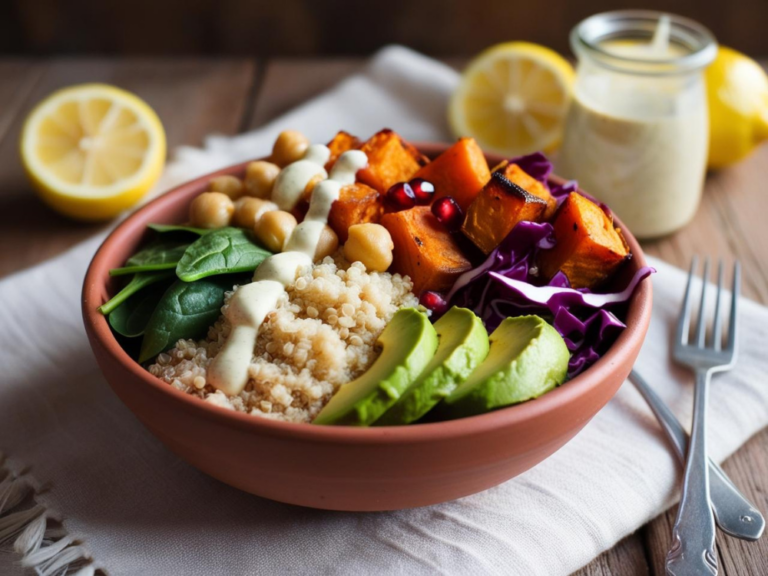
DIY Dressing Ideas: Take Your Buddha Bowl to the Next Level
One of the best parts about making a Buddha Bowl is the dressing—it’s the flavor-packed finishing touch that ties all the ingredients together. While the classic Lemon Tahini Dressing is creamy, zesty, and absolutely delicious, there’s no rule that says you have to stick to just one option. Making your own DIY dressings is a fun and creative way to customize your bowl to suit your cravings or dietary needs. Here are some incredible dressing ideas that you can easily whip up at home to keep your Buddha Bowls exciting and fresh.
1. Classic Lemon Tahini Dressing with a Twist
If you love the original dressing but want to change things up slightly, try these variations:
- Garlic Lovers: Add an extra clove of garlic and a pinch of smoked paprika for a bold and smoky flavor.
- Herb Infusion: Blend in fresh herbs like parsley, cilantro, or dill for a bright, herbaceous twist.
- Spicy Kick: Stir in a teaspoon of sriracha or cayenne pepper for a spicy tahini dressing that packs a punch.
2. Creamy Avocado Lime Dressing
This dressing is perfect if you’re craving something rich and velvety with a zesty kick:
- Ingredients:
- 1 ripe avocado
- Juice of 1 lime
- 2 tablespoons olive oil
- 1 garlic clove, minced
- 2–3 tablespoons water (to adjust consistency)
- Salt and pepper to taste
- Instructions: Blend all the ingredients until smooth. Add more water if needed to achieve a pourable consistency. This dressing pairs beautifully with fresh greens and roasted veggies.
3. Spicy Peanut Sauce
For a nutty, savory, and slightly spicy option, try this Asian-inspired peanut sauce:
- Ingredients:
- 1/4 cup creamy peanut butter
- 2 tablespoons soy sauce or tamari (for gluten-free)
- 1 tablespoon rice vinegar
- 1 tablespoon maple syrup or honey
- 1 teaspoon sriracha or chili paste
- 2–4 tablespoons warm water (to thin)
- Instructions: Whisk all the ingredients together until smooth. Adjust the heat level and consistency to your liking. This sauce pairs wonderfully with quinoa, chickpeas, and crunchy veggies like red cabbage.
4. Miso Ginger Dressing
For a savory, umami-packed dressing, miso is the secret ingredient:
- Ingredients:
- 2 tablespoons white miso paste
- 1 tablespoon grated ginger
- 1 tablespoon rice vinegar
- 1 tablespoon sesame oil
- 1 teaspoon honey or agave syrup
- 2–3 tablespoons water (to thin)
- Instructions: Whisk all ingredients together until smooth. This dressing adds a delicious Asian-inspired flavor to any Buddha Bowl.
5. Creamy Greek Yogurt Dressing
If you prefer a lighter, tangy dressing, Greek yogurt is a fantastic base:
- Ingredients:
- 1/2 cup plain Greek yogurt
- Juice of 1 lemon
- 1 tablespoon olive oil
- 1 teaspoon Dijon mustard
- 1 garlic clove, minced
- Salt and pepper to taste
- Instructions: Combine all ingredients in a bowl and whisk until smooth. This creamy dressing works beautifully with quinoa, roasted veggies, and fresh greens.
6. Zesty Cilantro Lime Dressing
Bright, tangy, and slightly herbal, this dressing is a great match for fresh and summery bowls:
- Ingredients:
- 1/2 cup fresh cilantro leaves
- Juice of 1 lime
- 2 tablespoons olive oil
- 1 garlic clove
- 1 teaspoon honey or agave syrup
- 2–3 tablespoons water (to thin)
- Instructions: Blend all the ingredients until smooth. Adjust the lime juice and water to achieve your desired tanginess and consistency.
7. Balsamic Vinaigrette
A classic option that adds a touch of sweetness and acidity to your bowl:
- Ingredients:
- 3 tablespoons olive oil
- 1 tablespoon balsamic vinegar
- 1 teaspoon Dijon mustard
- 1 teaspoon maple syrup
- Salt and pepper to taste
- Instructions: Whisk all the ingredients together in a small bowl. This simple yet flavorful dressing complements quinoa, greens, and roasted vegetables beautifully.
8. Turmeric Tahini Dressing
This vibrant, golden dressing not only looks stunning but also packs anti-inflammatory benefits:
- Ingredients:
- 1/4 cup tahini
- Juice of 1 lemon
- 1/2 teaspoon ground turmeric
- 1/4 teaspoon black pepper
- 2–3 tablespoons water (to thin)
- Instructions: Mix the tahini, lemon juice, turmeric, and black pepper in a bowl. Slowly add water to reach your desired consistency. This dressing is as flavorful as it is healthy.
9. Maple Dijon Dressing
A sweet and tangy dressing that’s perfect for autumn-inspired Buddha Bowls:
- Ingredients:
- 2 tablespoons Dijon mustard
- 1 tablespoon maple syrup
- 2 tablespoons olive oil
- 1 tablespoon apple cider vinegar
- Salt and pepper to taste
- Instructions: Whisk all ingredients together until smooth. This dressing pairs wonderfully with roasted sweet potatoes, Brussels sprouts, and quinoa.
10. Lemon Garlic Vinaigrette
A light and zesty option that keeps things simple and fresh:
- Ingredients:
- Juice of 1 lemon
- 3 tablespoons olive oil
- 1 garlic clove, minced
- 1 teaspoon honey or agave syrup
- Salt and pepper to taste
- Instructions: Whisk together the lemon juice, olive oil, garlic, and honey. Season with salt and pepper. This vinaigrette is ideal for highlighting the natural flavors of fresh greens and roasted veggies.
Why Make Your Own Dressing?
DIY dressings not only give you control over the ingredients but also allow you to customize the flavors to match your mood, dietary needs, or seasonal preferences. From creamy and rich to light and tangy, there’s a dressing here for everyone. Plus, making your own is often healthier and more cost-effective than store-bought options.
Try these dressing ideas with your next Buddha Bowl and discover how much of a difference the right sauce can make. And don’t forget to share your favorite combinations with us using #SatisfyYourCravings—we’d love to see your creations!
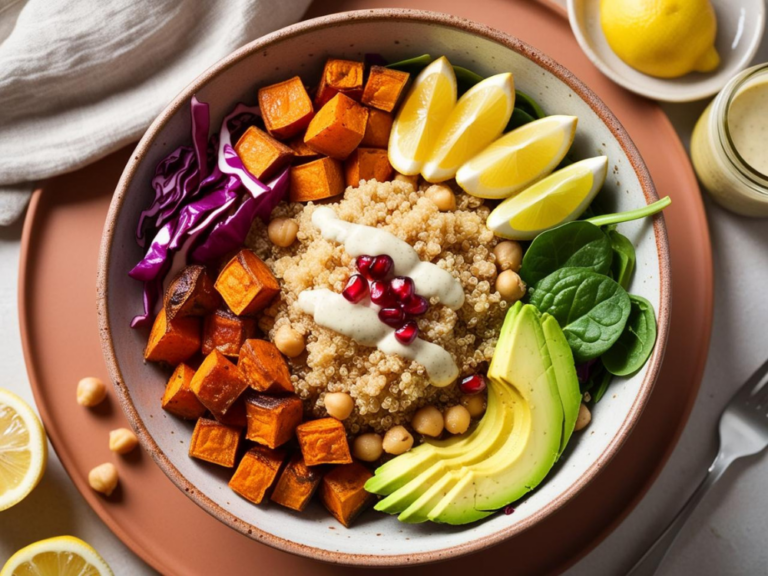
The History and Origin of Buddha Bowls
The term “Buddha Bowl” has become a buzzword in the food world, synonymous with colorful, nutrient-packed meals served in a single bowl. But where did this concept come from? Is it just a trendy name, or is there a deeper meaning behind it? Let’s explore the fascinating history and origins of Buddha Bowls and how they’ve evolved into the wholesome meals we love today.
The Symbolism of the Name
The name “Buddha Bowl” is said to be inspired by the image of Buddha’s rounded belly, which is a symbol of abundance, balance, and nourishment. The idea is that the bowl, when filled with a variety of healthy ingredients, represents a full, satisfying, and harmonious meal. This symbolism ties into the Buddhist principle of mindfulness, encouraging us to appreciate the food we eat and the effort that went into preparing it.
Some also connect the name to the idea of “eating like Buddha,” where meals are simple, balanced, and vegetarian. In many traditions, monks would carry a single bowl and accept small offerings of food from villagers. These offerings were often a mix of grains, vegetables, and legumes, creating a meal similar to what we now know as the Buddha Bowl.
Roots in Ancient Practices
The concept of a meal served in one bowl isn’t new—it has roots in ancient food traditions around the world:
- Asia: In Buddhist communities, meals were often vegetarian and served in a single bowl for simplicity and balance. This practice reflects the Buddhist value of minimalism and respect for the environment.
- India: The thali—a round plate or bowl filled with small portions of different dishes like lentils, rice, and vegetables—shares similarities with the modern Buddha Bowl.
- Japan: Bento boxes, which contain a variety of small dishes, also share the idea of balance and variety in a meal.
While these meals weren’t called “Buddha Bowls” historically, they laid the foundation for the concept of a balanced, plant-based meal served in a single container.
Modern Popularity
The term “Buddha Bowl” as we know it today began to gain traction in the early 2000s, driven by the growing interest in plant-based diets, clean eating, and mindful living. As people became more aware of the importance of eating whole, unprocessed foods, the Buddha Bowl emerged as a perfect way to combine variety, nutrition, and convenience.
Social media has played a huge role in the rise of Buddha Bowls. Their vibrant colors and beautiful arrangements make them incredibly photogenic, leading to their widespread popularity on platforms like Instagram and Pinterest. Health-conscious food bloggers and influencers have embraced Buddha Bowls as a way to showcase their creativity and share their love for healthy eating.
Why the Bowl?
The bowl itself plays a symbolic and practical role in the popularity of Buddha Bowls:
- Symbolic: The rounded shape of the bowl mirrors the imagery of Buddha’s belly and represents abundance and balance.
- Practical: Bowls are easy to handle, allow for creative layering, and make it simple to combine a variety of textures and flavors. They also create a sense of comfort and coziness, making the meal feel more personal and satisfying.
Evolution of Ingredients
While traditional Buddha Bowls were simple and plant-based, modern variations have become incredibly diverse. The ingredients can be tailored to any diet or cuisine, making Buddha Bowls accessible to everyone. Here’s how they’ve evolved:
- Base Options: Traditional grains like rice and quinoa have been joined by options like farro, couscous, and cauliflower rice.
- Protein Choices: In addition to plant-based proteins like chickpeas and tofu, some versions now include grilled chicken, eggs, or fish.
- Diverse Veggies: From roasted sweet potatoes to fresh spinach and pickled red cabbage, the possibilities are endless.
- Global Flavors: Modern Buddha Bowls often borrow from various cuisines, incorporating flavors like miso, tahini, curry, or spicy peanut sauce.
A Meal for Mindful Eating
At its core, the Buddha Bowl is more than just a trendy dish—it’s a meal rooted in mindfulness and balance. The process of building a Buddha Bowl encourages you to think about the variety of ingredients, their nutritional value, and how they come together to create a meal that nourishes your body and soul. It’s an opportunity to slow down, savor the flavors, and appreciate the food on your plate.
Why We Love Buddha Bowls Today
The beauty of Buddha Bowls lies in their flexibility and ability to suit any lifestyle. Whether you’re vegan, gluten-free, or just looking for a delicious way to eat more vegetables, a Buddha Bowl can be customized to meet your needs. They’ve become a symbol of modern healthy eating, combining ancient traditions with contemporary creativity.
So the next time you enjoy a Buddha Bowl, remember its rich history and the principles of balance and abundance it represents. And don’t forget to share your vibrant creations with us using #SatisfyYourCravings! Who knew that a simple bowl could carry so much meaning?
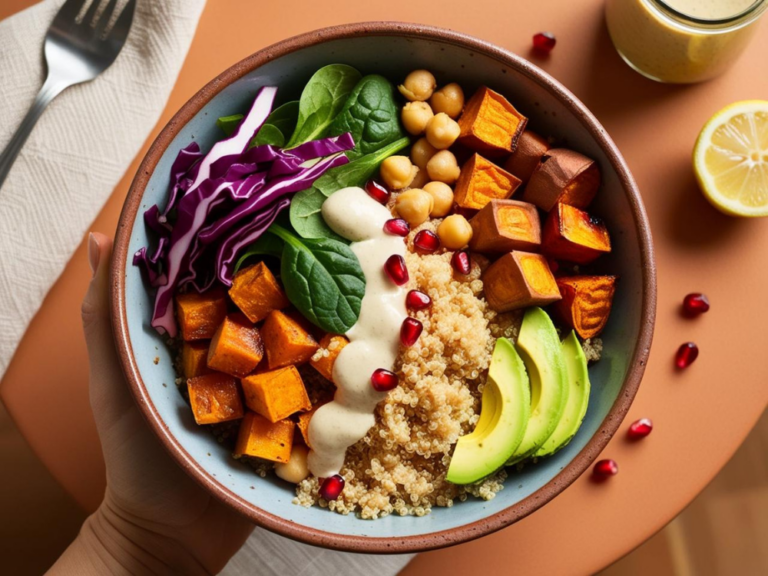
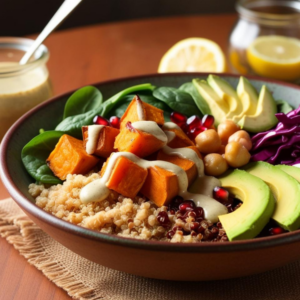
Quinoa Buddha Bowl with Lemon Tahini Dressing
Equipment
- Medium saucepan: For cooking quinoa.
- Baking Sheet: To roast the sweet potatoes.
- Mixing Bowls: For tossing ingredients and mixing the dressing.
- Cutting Board and Knife: For chopping vegetables like sweet potatoes, avocado, and cabbage.
- Whisk or Fork: To mix the Lemon Tahini Dressing until smooth.
Ingredients
For the Bowl
- 1 Cup Quinoa
- 2 Cups Water or vegetable broth
- 1 Cup Roasted sweet potato, cubed
- 1 Cup Cooked chickpeas
- 1 Cup Fresh spinach or kale, chopped
- ½ Cup Red cabbage, thinly sliced
- ½ Avocado, sliced
- ¼ Cup Pomegranate seeds (optional, for garnish)
For the Lemon Tahini Dressing
- ¼ Cup Tahini
- 2 Tbsp Fresh lemon juice
- 1 Tbsp Olive oil
- 1 Tsp Maple syrup (or honey)
- 1 Garlic clove, minced
- 2-3 Tbsp Water (to adjust consistency)
- Salt and pepper, to taste
Instructions
- 1. Prepare the Quinoa:Rinse the quinoa under cold water to remove any bitterness.In a medium saucepan, combine quinoa and water (or vegetable broth) and bring to a boil.Reduce heat to low, cover, and simmer for 15 minutes, or until the quinoa is tender and the liquid is absorbed.Fluff with a fork and set aside to cool slightly.
- 2. Roast the Sweet Potatoes:Preheat your oven to 400°F (200°C).Toss cubed sweet potatoes with a drizzle of olive oil, salt, and pepper.Spread them evenly on a baking sheet and roast for 20–25 minutes, flipping halfway through, until golden and tender.
- 3. Prepare the Lemon Tahini Dressing:In a small bowl, whisk together tahini, lemon juice, olive oil, maple syrup, minced garlic, and a pinch of salt and pepper.Gradually add water, one tablespoon at a time, until the dressing reaches your desired consistency. It should be creamy yet pourable.
- 4. Assemble the Bowl:Divide the cooked quinoa among serving bowls.Arrange the roasted sweet potatoes, chickpeas, spinach or kale, red cabbage, and avocado on top of the quinoa.Drizzle generously with the Lemon Tahini Dressing.Sprinkle pomegranate seeds for a burst of sweetness, if desired.
Notes
Make Ahead and Storage Tips
The Quinoa Buddha Bowl with Lemon Tahini Dressing is perfect for meal prep and can be easily stored to enjoy throughout the week. By preparing the components in advance, you can save time and still enjoy a fresh, flavorful meal whenever you’re ready. Here’s how to make the most of your prep and storage:How to Make It Ahead
-
Quinoa:
- Cook the quinoa in advance and let it cool completely before storing it in an airtight container.
- Store in the refrigerator for up to 5 days.
- To reheat, microwave for 1–2 minutes or serve it cold as a base for your bowl.
-
Roasted Sweet Potatoes:
- Roast the sweet potatoes ahead of time and let them cool before placing them in an airtight container.
- Store in the refrigerator for up to 5 days.
- Reheat in the oven, air fryer, or microwave to restore their warmth and crispness.
-
Chickpeas:
- If using roasted chickpeas, prepare them in advance and let them cool completely before storing in an airtight container.
- Store at room temperature for up to 3 days (if roasted) or in the refrigerator for 5 days (if not roasted).
-
Fresh Vegetables:
- Wash and chop veggies like spinach, red cabbage, and any others in advance.
- Store them in separate airtight containers lined with a paper towel to absorb moisture and keep them crisp.
- Wait to slice avocado until just before serving to prevent browning.
-
Lemon Tahini Dressing:
- Prepare the dressing and store it in a sealed jar or container.
- Keep in the refrigerator for up to 5 days.
- Shake or stir before using, as the ingredients may separate over time.
How to Store Leftovers
-
Assembled Bowls:
- If you’ve already assembled the bowl, it’s best to store components separately to keep everything fresh. However, if stored together:
- Use an airtight container.
- Consume within 2–3 days for the best flavor and texture.
- Store the dressing separately to prevent the ingredients from becoming soggy.
- If you’ve already assembled the bowl, it’s best to store components separately to keep everything fresh. However, if stored together:
-
Separate Components:
- Store each ingredient in its own container to maintain freshness. This method is ideal for meal prep and ensures your veggies stay crisp and your grains and proteins are ready to reheat.
Freezing Tips
-
Quinoa and Sweet Potatoes:
- These components freeze well and can be stored in freezer-safe containers or bags for up to 3 months.
- Defrost in the refrigerator overnight and reheat before serving.
-
Avoid Freezing Fresh Veggies and Dressing:
- Fresh vegetables like spinach, red cabbage, and avocado don’t freeze well and may become wilted or mushy when thawed.
- The tahini dressing can separate and change texture when frozen, so it’s best made fresh or stored in the refrigerator.
Quick Assembly for Busy Days
When it’s time to eat, simply layer your prepped ingredients in a bowl, drizzle with the Lemon Tahini Dressing, and enjoy! By prepping ahead and storing components properly, you’ll have a healthy, delicious meal ready in minutes. Whether you’re meal prepping for the week or storing leftovers, this Buddha Bowl is an easy and versatile option to keep you fueled and satisfied.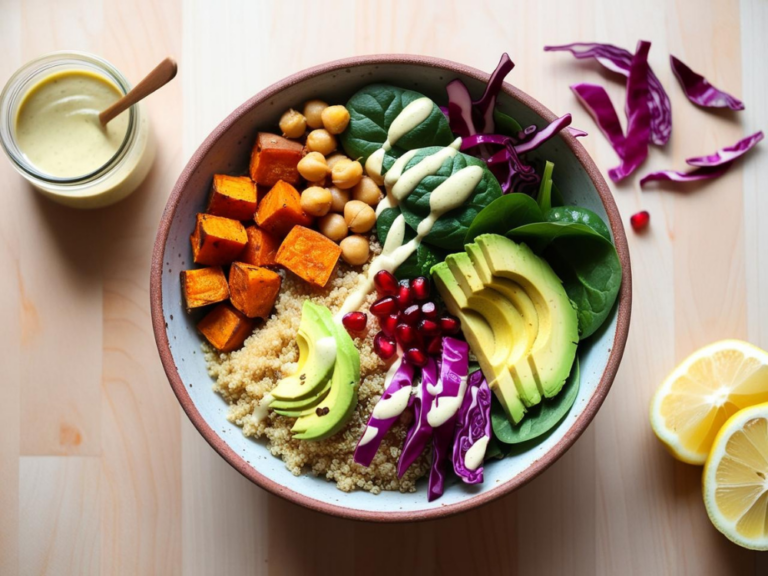
A Bowl of Nourishment and Joy
The Quinoa Buddha Bowl with Lemon Tahini Dressing isn’t just a meal—it’s a celebration of wholesome, vibrant ingredients coming together in perfect harmony. Each bite is a reminder that healthy eating can be flavorful, satisfying, and nourishing for both the body and soul. From the fluffy quinoa and roasted sweet potatoes to the zesty dressing that ties it all together, this dish is a testament to the power of clean, simple food.
Whether you’re preparing it for a quick lunch, a family dinner, or as part of your weekly meal prep, this Buddha Bowl is as versatile as it is delicious. Plus, its endless customization options make it a dish you’ll never get tired of experimenting with.
I hope this recipe inspires you to embrace the beauty of balanced eating and to enjoy the process of creating meals that make you feel good from the inside out. When you try it, don’t forget to share your creation with us using #SatisfyYourCravings—we’d love to see how you make it your own! Here’s to eating well, living well, and savoring every bite.
Join Now!
Love this recipe? Don’t miss out on even more delicious, healthy, and easy-to-make recipes like this Quinoa Buddha Bowl with Lemon Tahini Dressing! By joining our email community, you’ll gain access to exclusive content, bonus recipes, and tips to make clean eating a breeze.
Enter your email & click below to subscribe and start receiving tasty inspiration right away. It only takes a minute to join our growing community of food lovers dedicated to making healthy eating delicious and fun.

